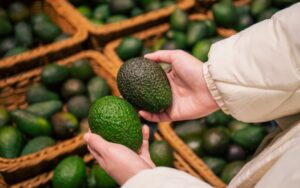Avocados have gained immense popularity for their creamy texture and numerous health benefits. But before indulging in this delicious fruit, it’s important to know the best way to wash an avocado and whether it’s necessary to do so.
In this article, we will provide you with a step-by-step guide on How to Clean an Avocado effectively, addressing the question of whether you should wash avocados or not.
Avocados are not only delicious but also packed with essential nutrients like healthy fats, fiber, and vitamins. To ensure the highest level of food safety, it is recommended to follow proper washing practices for avocados. Let’s explore whether you need to wash avocados and the reasons behind it.
Do you need to wash avocados?
Yes, it is advisable to wash avocados even though they have a thick outer skin that is typically not consumed. Washing avocados removes potential contaminants such as dirt, bacteria, and pesticide residues that could transfer to the inner flesh during the cutting process.
How to Wash an Avocado – Is it important?
Cleaning avocados serves multiple purposes. Firstly, it eliminates any dirt or debris that might be present on the skin, enhancing the overall cleanliness of the fruit. Secondly, it helps remove harmful bacteria like Salmonella or E. coli, reducing the risk of foodborne illnesses.
Lastly, washing avocados removes pesticide residues, if any, minimizing exposure to potentially harmful chemicals.
How to Wash an Avocado – The necessary supplies
Before you begin washing avocados, gather the following supplies:
- A clean cutting board
- A sharp knife
- Running water
Step 1: Rinsing the avocado
Start by rinsing the avocado under cool running water. This initial rinse helps remove any loose dirt or debris present on the skin. Gently rub the avocado with your hands to ensure thorough rinsing.
Step 2: Scrubbing the avocado
For an extra level of cleanliness, you can use a clean brush or your fingers to gently scrub the avocado’s skin. This helps remove any stubborn dirt or residues clinging to the surface. Remember to handle the avocado with care to prevent bruising.
Step 3: Rinsing again
After scrubbing, rinse the avocado once more under running water. Ensure that all the soap, if used, and any remaining contaminants are washed away.
Step 4: Drying the avocado
After rinsing, pat the avocado dry using a clean kitchen towel or paper towel. It’s important to remove excess moisture to prevent bacterial growth. Avoid rubbing the avocado vigorously to avoid damaging the fruit.
Storing washed avocados
Once the avocado is dry, it can be stored or used immediately. If you’re not planning to use it right away, store it in a cool, dry place away from direct sunlight. If you have already sliced the avocado, store it in an airtight container or cover it with plastic wrap to prevent browning.
How to Wash an Avocado – Conclusion
Washing avocados is an essential step in ensuring food safety and reducing the risk of contamination. Although the outer skin is not typically eaten, it can harbor dirt, bacteria, and pesticide residues. By following the simple steps outlined in this article, you can wash avocados effectively and enjoy this nutritious fruit with confidence. Remember to rinse, scrub, and dry the avocados thoroughly before storing or using them. Prioritizing proper washing practices enhances both the cleanliness and safety of avocados.




